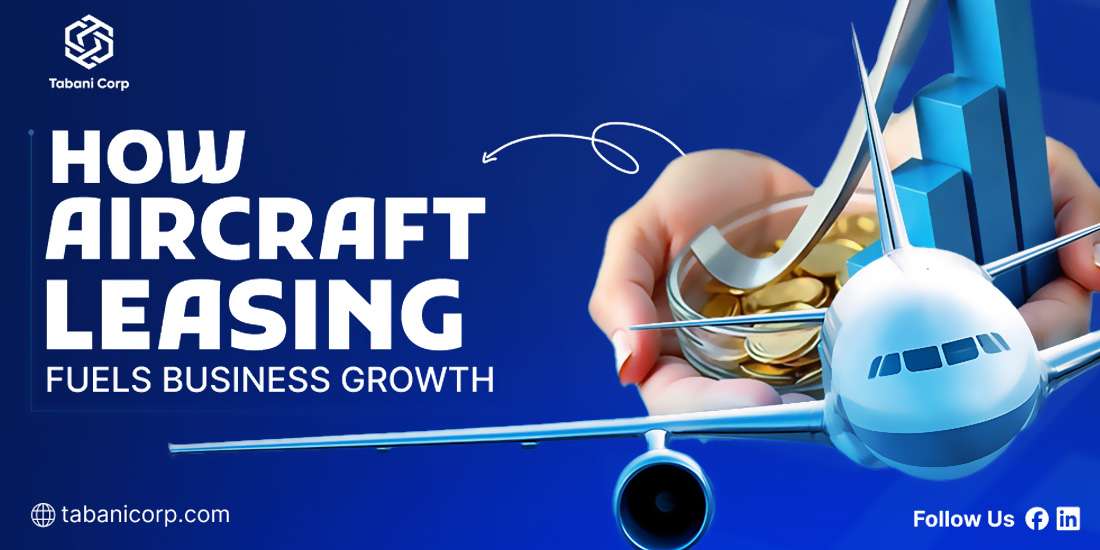How Aircraft Leasing Fuels Business Growth
 18 August, 2025
18 August, 2025
In regions where underdeveloped infrastructure often limits mobility, yet business ambition shows no signs of slowing, air travel begins to serve a far greater purpose. Aircraft are no longer viewed simply as transport; they’re recognized as vital enablers of growth, access, and execution.
Particularly to commercial and industrial companies that run cross-border activities or operate in distant regions, a reliable aviation choice is more than convenience. It makes sure that high-level decision-makers get where they need to be, that special cargo delivery is timely, and that business momentum is not stalling. Aircraft leasing in this respect has provided a practical alternative, providing the speed and variety of airline travel, without the financial and operational burden of owning.
Pakistan, in particular, stands at a defining moment. As new economic corridors opens and industrialization of regions advances, mobility ceases to be a secondary issue; it is competitiveness. With more businesses concentrating on expanding and accessing contracts, and dealing with changing market demands, aviation access via leasing is not only convenient, but is becoming vital.
Aircraft as a Business Asset: Beyond Transport
Aircraft are no longer just tools of travel; they are becoming instruments of business execution. In industries where timing, access, and control are non-negotiable, aviation plays a vital role in maintaining operational momentum.
Airplanes are not only traveling tools anymore, as they are turning into a medium to conduct business. Aviation is essential in an industry where the luxury of time, access, and control are non-negotiable in any way.
Strategic Use in Industrial Operations
From time-critical cargo to executive deployment and rapid site access, aircraft are helping companies:
- Reach remote manufacturing zones or project sites
- Transport high-value or sensitive goods under tight deadlines
- Ensure leadership presence across geographically dispersed operations
- Maintain project integrity where the road or rail is unreliable
Business Impact in Emerging Markets
In economies like Pakistan, ground infrastructure often presents real barriers. Delays are costly, both in terms of revenue and reputation. By utilizing aircraft, businesses eliminate such risks and gain a strategic edge, operating not on available infrastructure but on their own terms.
Asset Without the Burden
Leased aircraft allow companies to:
- Access aviation mobility without the high cost of ownership
- Scale operations without long-term asset commitments
- Integrate flexible air logistics into broader expansion plans
Those who view aviation not as an expense, but as a tool of efficiency and influence, are better positioned to lead. Aircraft, when used strategically, unlock faster execution, stronger client relationships, and a broader operational footprint.
Why Leasing Makes Financial Sense for Industrial Giants
Aircraft leasing ensures the release of valuable capital, which can be allocated to investment in the business, which can either mean expansion in production levels, investments in new technology, or venturing into new markets. The capacity to maintain liquidity without affecting operational scope is a major financial benefit to the industrial enterprise.
Owning an aircraft means bearing the full cost of acquisition, maintenance, insurance, and compliance. These expenses can drain resources that might otherwise support growth. Leasing transfers much of that financial responsibility to the lessor, while still granting the lessee full operational access.
Operational Access Without Long-Term Commitment
- Shorter-term leases allow businesses to meet specific project or seasonal demands.
- Longer-term finance leases can offer purchase options without requiring upfront capital.
This flexibility assists businesses in shifting their aviation strategy with their change of needs. Leasing allows newer aircraft with more fuel efficiency, less maintenance expenses and updated avionics to be accessed without facing the depreciation risk that accompanies ownership. Businesses get performance and reliability while keeping their financial models lean.
Smarter Financial Planning
- Predictable monthly costs
- No sudden outlays for repairs or compliance upgrades
- Opportunities to structure leases for tax efficiency
These financial advantages make leasing an attractive option for CFOs seeking to optimise both balance sheets and operational capabilities.
Expansion, Agility & Control: What Leasing Unlocks
Aircraft leasing isn’t merely a financial workaround—it’s a strategic accelerator. For industrial and commercial enterprises operating in competitive and time-sensitive sectors, the ability to move fast, adapt quickly, and reach new territories often defines success. Leasing offers that flexibility without the operational drag of ownership.
In real-world business scenarios, leased aircraft have helped companies:
- Enter new regional markets without being limited by ground transport infrastructure
- Deploy technical teams and executives on short notice to project sites, client locations, or government negotiations
- Enhance client relationships by enabling direct access to underserved or remote areas
The ability to scale operations geographically, respond to market shifts, and move decision-makers efficiently gives leasing a distinct operational edge. In countries like Pakistan, where speed of execution can make or break a deal, having access to aircraft on demand is not just a convenience; it’s a competitive advantage.
What leasing really delivers is control over schedules, over logistics, over market access. It gives businesses the freedom to operate at their own pace, without being tied to rigid infrastructure timelines or heavy capital expenditures.
Operating vs. Finance Lease: Which Suits Which Business Model
Choosing the right leasing structure isn’t just about cost but about aligning aviation access with your broader business strategy. Each lease type serves a different purpose, depending on how a company intends to use the aircraft and manage its capital. Below is a strategic breakdown:
| Aspect | Operating Lease | Finance Lease |
| Best For | Short-term or project-based needsSeasonal or trial expansions | Long-term aviation integrationStable, high-frequency usage |
| Ownership | Remains with the lessor | Transfers to the lessee at the end (optionally) |
| Upfront Capital | Low | Moderate to high |
| Balance Sheet Impact | Off-balance sheet (in many cases)Considered an expense | Considered a capital assetImpacts depreciation and liabilities |
| Flexibility | High: Return or upgrade aircraft easily | Moderate: Long-term commitment |
| Customization | Limited | High: Aircraft can be tailored to operational needs |
| End-of-Term Options | Return or renew the lease | Purchase the aircraft or extend ownership |
| Ideal For | Project-driven companiesLogistic operators with fluctuating demandMarket testing in new regions | Corporates needing dedicated executive mobilitySpecialized cargo or logistics providersFirms integrating aviation into core operations |
A Pakistan-Centric Perspective: The Role of Aviation in Industrial Growth
Scenario 1: Industrial Projects in Remote Regions
The Challenge:
Infrastructure development projects, like those in Balochistan, Gilgit-Baltistan, or interior Sindh, often face delays due to difficult terrain and unreliable ground transport.
How Leasing Helps:
Leased aircraft enable rapid deployment of technical teams, equipment, and materials to remote project sites, keeping timelines on track and minimizing logistical disruptions.
Scenario 2: Cross-Border Trade and Executive Mobility
The Challenge:
With expanding trade ties, especially under initiatives like CPEC, executives and managers often need to travel between Pakistan, China, and Central Asia on tight schedules. Commercial flight routes don’t always align with business needs.
How Leasing Helps:
Private or shared charter leases provide flexibility, allowing business leaders to optimize travel time, improve client response, and manage high-level negotiations without delay.
Scenario 3: Public-Private Sector Collaboration
The Challenge:
Many industrial initiatives involve partnerships with government bodies, requiring coordination across cities and ministries, often with time-bound decisions or joint site visits.
How Leasing Helps:
Aircraft leasing creates seamless access for joint delegations, compliance teams, or investor groups, helping accelerate approvals, funding discussions, or inspections.
Strategic Fit: With its active role in national industrial progress, Tabani Corp recognizes how aviation access strengthens public-private collaboration, facilitating real impact where speed and coordination are essential.
Bottom Line:
In Pakistan’s evolving industrial landscape, aircraft leasing is proving to be more than a convenience—it’s becoming a necessity. It offers the mobility, control, and responsiveness that large-scale operations require to stay competitive.
Risk Management and Future-Proofing through Leasing
Leasing aircraft is not just about gaining access; it’s about staying agile in an unpredictable world. In industries where every delay carries financial risk and where technology evolves faster than infrastructure, aircraft leasing offers built-in safeguards. Here’s how:
Avoid Long-Term Asset Obsolescence
- Aviation technology evolves rapidly. Owning an aircraft ties a company to a depreciating asset.
- Leasing allows businesses to upgrade periodically, ensuring access to more fuel-efficient and regulation-compliant aircraft.
Minimize Maintenance and Compliance Burdens
- Maintenance, airworthiness directives, and aviation compliance involve substantial ongoing costs.
- Leasing agreements often include built-in technical support or pass these responsibilities to the lessor, reducing operational headaches for the lessee.
Scale Operations Without Financial Strain
- Leasing offers variable-term options that align with business cycles—ideal for seasonal operations or temporary surges in demand.
- It helps avoid long-term financial lock-in, especially in volatile markets.
Navigate Regulatory and Geopolitical Uncertainty
- Businesses operating across regions often face shifting airspace policies, tariffs, or bilateral restrictions.
- Leasing provides the flexibility to adapt quickly, changing routes, aircraft types, or service providers without sunk investment costs.
Strengthen Disaster and Emergency Readiness
- For companies involved in infrastructure, energy, or critical logistics, access to aircraft during crises (natural disasters, supply chain breakdowns, political instability) is invaluable.
- Leasing arrangements can be structured with standby options, giving businesses a reliable Plan B when needed most.
Elevating Vision with Aviation Strategy
In Pakistan’s evolving industrial landscape, where mobility, speed, and responsiveness define success, aviation is not a luxury; it’s a growth strategy. Leasing unlocks the ability to move decisively, enter untapped markets, serve remote projects, and adapt with precision to changing demands.
At Tabani Corp, we understand what it means to build with vision and to scale with purpose. Our longstanding commitment to national progress, industrial innovation, and global partnerships has always been rooted in strategic thinking. Aircraft leasing is one of many tools we advocate for enterprises ready to lead in new markets, optimize their operations, and drive transformative growth.
Tabani Corp continues to empower forward-looking companies across Pakistan and beyond with insights, access, and solutions that align with tomorrow’s challenges. Let aviation strategy become part of your growth blueprint, because building the future means thinking several moves ahead.

